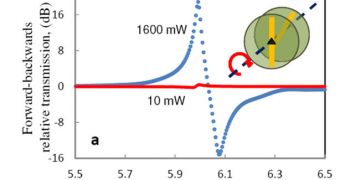A team of experts managed to create a diode-like device that allows electromagnetic waves to pass in one direction, but prevents them from going the opposite way. The innovation could have a wide array of practical applications.
The new diode was constructed specifically for polarized microwaves, the group explains, and it is made up of metamaterials, a class of materials with peculiar physical properties.
To understand just how weird these materials are, consider that they are used to create invisibility cloaks and artificial black holes for radiation, given that they can bend light in twisted ways.
On the other hand, a diode is a small electronic device that allows for the passing of electrical current through in one direction, but not in the opposite one.
This trait has made them invaluable to the electronics industry, and there are now very few electronic devices that do not carry at least a small number of diodes.
Another way to look at diodes is as one of the fundamental building blocks of today's technologies. This is why physics teams around the world have been looking to make a similar device that can handle light and other wavelengths in the electromagnetic spectrum.
But one of the main issues with electromagnetic diodes is that they have a linear response, meaning that they output as much light as you put in. Electric diodes have a non-linear response, where a small change in the input can cause massive variations in the output.
What the new study did was develop a method of creating electromagnetic diodes in such a way that the devices have a non-linear response. This was done by enlisting the help of metamaterials.
The achievement comes from physicists at the Australian National University in Canberra, who are led by expert Ilya Shadrivov. They published the research in the online scientific journal arXiv.
A diode-like behavior can be obtained in the new device by using two metamolecules, the building blocks of metamaterials. Each molecule is made up of two wires separated by a dielectric sheet.
The wires are rotated relative to each other in order to obtain the desired effect. When microwaves are passed through the metamaterial, they generate currents in each of the wires, Technology Review reports.
These currents interact at specific frequencies. If experts fine-tune these frequencies, they can get the currents to either re-enforce each other, or even cancel each other out.
A breakthrough in research came when experts demonstrated that adding a diode to one of the wired instills a non-linear behavior in the metamaterial as a whole.
The innovation could make the creation of electronic logic circuits simpler and cheaper, therefore leading to a revolution in the electronics industry.

 14 DAY TRIAL //
14 DAY TRIAL //